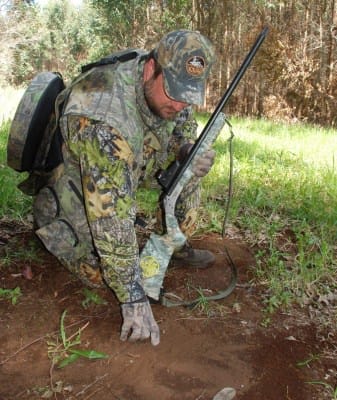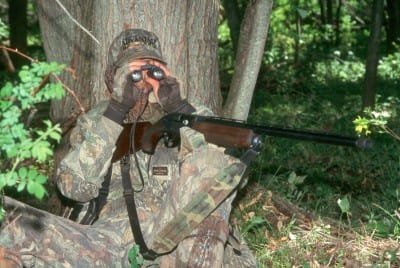
The most successful turkey hunters hunt for five weeks, but they scout 365 days a year. If you want to be consistently successful in the spring, an old boy told me, you’re always scouting. You’re always looking and listening, he continued. Deer season, squirrel season, the off-season, even while you’re crappie fishing, he said, you’re doing your homework. Come turkey season, you know where you’re going. Maybe, he said with a grin, not what you’re doing, but at least you know where the birds are.
The old boy’s right—turkey scouting is an on-going process that involves more than simply wandering around a week prior to the opener hoping you’ll see or hear something. The more you treat turkeys like the big game animals they are, I always tell my listeners during hunting seminars, the more successful you’re going to be afield. Successful as in guaranteed harvest? Certainly not, but at least you’re going to be in the right spot.
So how do treat gobblers like big game animals when it comes to scouting? I tend to view my turkey scouting via the calendar. Different months mean I’m looking for different things, and often using different methods. With that in mind, let’s take a look at my “Turkey Calendar,” and see how I’m preparing for opening day.
September through January
Otherwise known as hunting season, the months of September through January see me chasing squirrels. As I’m in the timber already, and sitting quietly for the most part, this activity gives me plenty of observation time. Where are birds roosting? Where do they water? Are they crossing property lines or fences, and if so, where and how? Turkeys, like whitetails, can have a consistent routine, at least until human disturbance alters that routine. Knowing this, I can transpose what I see in the fall to the spring, and at the very least provide myself with a jumping-off point for more in-depth scouting.

The hunting months, too, give me a chance to evaluate the spring hatch and summer survival on my properties. Are there lots of jakes? Are the longbeards 2-year-olds, or am I seeing higher numbers of older birds? This information will help me when it comes to making tactical decisions, such as decoy use.
February
Here in Iowa, we’ve seen longbeards strutting, with some gobbling activity, as early as mid-February. However, it’s usually later in the month, if not into March before the action really begins. That said, I spend much of February talking with local landowners “All right if Julia Carol and I hunt turkeys again?” and “What have you been seeing while you’re doing chores?” are my two biggest questions. I always have binoculars with me, and I’m spying on flocks against the snow cover while keeping my distance. There’s no sense in stressing birds coming off a hard winter, or throwing a wrench in what would have otherwise been predictable.
Finally, February gives me the opportunity to see if my hunting properties have changed physically. Has Farmer X bulldozed and chisel-plowed a valley, and in doing so taken out several regular roost trees? Is there new five-strand barbed wire strung between Properties One and Two? Opening day is not the time to discover your favorite oak knob has been turned into high-quality gunstocks and furniture. Have I seen it? Unfortunately, yes.

March
March marks the turkey opener in Florida, as well as in several other southern states. If you’re in one of those, your March should have been February in terms of your calendar. Here in The Hawkeye State, though, March means I’m getting serious. The last few landowners are spoken to, and I’m essentially living in my truck on the gravel roads. Still, I’m getting my information unobtrusively—I’m not barging into the timber. Morning and evening, you’ll find me at traditional haunts listening for gobbles and answering questions like how many, where are they roosted exactly and are they jakes or longbeards?
As March closes out, I’m now getting my boots dirty, scouting as if I were hunting. Subtle, stealthy, quiet, with a lot of emphasis on binoculars and not letting the birds see me. Calls? Absolutely no turkey calls, but I will have an owl hooter or coyote howler with me.
April
It’s all coming down to the final two weeks. Dawn and dusk, I’m parked or I’ve walked in quietly and sat down and I’m listening. I’m taking notes as to what I hear and see. These notes will help me decide exactly where I’m going to be opening morning, down to the tree. The night before the opener, I’ll try to roost a bird. Some years, though, I have to improvise and adjust based on his nighttime location. My gear’s ready, but I’m not kidding myself that I’ll get any sleep. The alarm screams almost unexpectedly—hell, I was up already. It’s here, it’s turkey season!
May
May, for me, translates into hunt/scout combos. Often, I’ll sit afternoons over two or three decoys, stroking a pot call quietly every now and then, but more so watching and plotting for the following morning. With luck, my father will have drawn a non-resident muzzleloader tag for Iowa, and I’ll be blessed to share several mornings with him. I’ll take a local 15-year-old out, and, hopefully, give him a firsthand introduction to the Sultan of Spring. It’s winding down now, but it’s been a good one.
June through August
It’s over, but that’s a good thing. For the past five weeks, my bills have gone unpaid, my face unshaven, my phone unanswered, and my refrigerator unstocked; funny, but I hadn’t even noticed. It’s summer, and I can relax, no more turkey hunting, at least until October. You did know about the fall turkey season, didn’t you?



